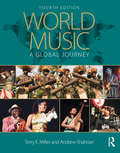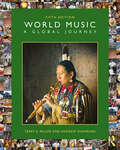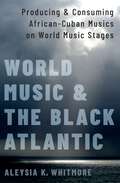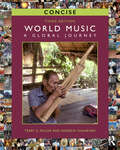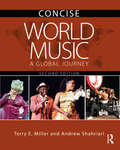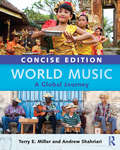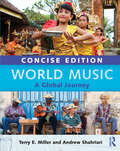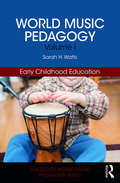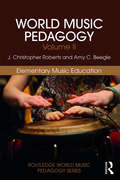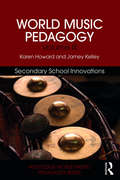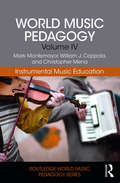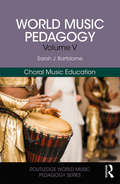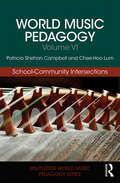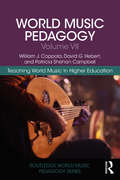- Table View
- List View
World Music: A Global Journey - eBook & mp3 Value Pack
by Terry E. Miller Andrew ShahriariWorld Music: A Global Journey, Fourth Edition takes students around the world to experience the diversity of musical expression and cultural traditions. It is known for its breadth in surveying the world's major cultures in a systematic study of world music within a strong pedagogical framework. As one would prepare for any journey, each chapter starts with background preparation, reviewing the historical, cultural, and musical overview of the region. Visits to multiple "sites" within a region provide in-depth studies of varied musical traditions. Music analysis begins with an experiential "first impression" of the music, followed by an "aural analysis" of the sound and prominent musical elements. Finally, students are invited to consider the cultural connections that give the music its meaning and life. Fourth Edition features: New sites! Plena from Puerto Rico Chuida from China Gagaku from Japan has returned from the Second Edition New "Inside Look" features spotlight distinguished ethnomusicologists such as Dr. Terence Liu, K.S. Resni, Dr. Sumarsam, Dr. Mick Moloney, Walter Mahovlich, Natalie MacMaster, and Gilbert Velez Addition of DANCE, inseparable to musical expression in some cultures Updates as needed, resulting from various changes in culture, politics, and war New and revised test questions, new photos, and other revised resources The dynamic companion website hosts interactive listening guides plus many student and instructor resources. A set of three CDs is available, with over three hours of diverse music examples necessary to the study. PURCHASING OPTIONS Print Paperback Pack - Book and CD set: 9781138911277 Print Hardback Pack - Book and CD set: 9781138911284 Audio CD: 9781138697805 eBook Pack - eBook and mp3 file: 9781315692791* *See VitalSource.com for various eBook options (mp3 audio compilation not available for separate sale)
World Music: A Global Journey - eBook & mp3 Value Pack
by Terry E. Miller Andrew ShahriariWorld Music: A Global Journey, Fourth Edition takes students around the world to experience the diversity of musical expression and cultural traditions. It is known for its breadth in surveying the world's major cultures in a systematic study of world music within a strong pedagogical framework. As one would prepare for any journey, each chapter starts with background preparation, reviewing the historical, cultural, and musical overview of the region. Visits to multiple "sites" within a region provide in-depth studies of varied musical traditions. Music analysis begins with an experiential "first impression" of the music, followed by an "aural analysis" of the sound and prominent musical elements. Finally, students are invited to consider the cultural connections that give the music its meaning and life. Fourth Edition features: New sites! Plena from Puerto Rico Chuida from China Gagaku from Japan has returned from the Second Edition New "Inside Look" features spotlight distinguished ethnomusicologists such as Dr. Terence Liu, K.S. Resni, Dr. Sumarsam, Dr. Mick Moloney, Walter Mahovlich, Natalie MacMaster, and Gilbert Velez Addition of DANCE, inseparable to musical expression in some cultures Updates as needed, resulting from various changes in culture, politics, and war New and revised test questions, new photos, and other revised resources The dynamic companion website hosts interactive listening guides plus many student and instructor resources. A set of three CDs is available, with over three hours of diverse music examples necessary to the study. PURCHASING OPTIONS Print Paperback Pack - Book and CD set: 9781138911277 Print Hardback Pack - Book and CD set: 9781138911284 Audio CD: 9781138697805 eBook Pack - eBook and mp3 file: 9781315692791* *See VitalSource.com for various eBook options (mp3 audio compilation not available for separate sale)
World Music: A Global Journey
by Andrew Shahriari Terry E. MillerWorld Music: A Global Journey, Fifth Edition, explores the diversity of musical expression around the world, taking students across the globe to experience cultural traditions that challenge the ear, the mind, and the spirit. It surveys world music within a systematic study of the world’s major cultures, supported by a strong pedagogical framework. Providing historical and cultural overviews of the world’s seven continents, and fortified by in-depth studies of varied musical traditions, World Music: A Global Journey is known for its student-friendly approach and lively visits to “sites” that host musics of the world. The robust companion website with audio is ideal for online coursework. FEATURES Easy-to-follow proven chapter structure, organized by geographic region Listening Guides, detailed maps, and hundreds of colorful photos, with more than two dozen new images Coverage of an eclectic blend of world musics, including both popular and traditional music New “Inside Look” entries spotlight distinguished ethnomusicologists and musicians, such as Patricia Shehan-Campbell, Oleg Kruglyakov, Chan E. Park, Vivek Virani, and Mia Gormandy New “Musical Markers” feature that summarizes key musical elements of each audio example New site visiting Georgia, a new “Explore More” feature focused on Slovenian Polka, a new track for North Indian Raga with sitar, and much more New streamed music delivery! Hosted on the book’s dedicated website Audiobook—extra value! Presented by chapter on the book website Used in classrooms around the globe, World Music: A Global Journey, Fifth Edition, is an internationally acclaimed and best-selling fundamental resource for students and instructors to begin their exploration of world music and culture.
World Music and the Black Atlantic: Producing and Consuming African-Cuban Musics on World Music Stages
by Aleysia K. WhitmoreIn the mid-20th century, African musicians took up Cuban music as their own and claimed it as a marker of black Atlantic connections and of cosmopolitanism untethered from European colonial relations. Today, Cuban/African bands popular in Africa in the 1960s and '70s have moved into the world music scene in Europe and North America, and world music producers and musicians have created new West African-Latin American collaborations expressly for this market niche. World Music and the Black Atlantic follows two of these bands, Orchestra Baobab and AfroCubism, and the industry and audiences that surround them-from musicians' homes in West Africa, to performances in Europe and North America, to record label offices in London. World Music and the Black Atlantic examines the intensely transnational experiences of musicians, industry personnel, and audiences as they collaboratively produce, circulate, and consume music in a specific post-colonial era of globalization. Musicians, industry personnel, and audiences work with and push against one another as they engage in personal collaborations imbued with histories of global travel and trade. They move between and combine Cuban and Malian melodies, Norwegian and Senegalese markets, and histories of slavery and independence as they work together to create international commodities. Understanding the unstable and dynamic ways these peoples, musics, markets, and histories intersect elucidates how world music actors assert their places within, and produce knowledge about, global markets, colonial histories, and the black Atlantic. World Music and the Black Atlantic offers a nuanced view of a global industry that is informed and deeply marked by diverse transnational perspectives and histories of transatlantic exchange.
World Music CONCISE: A Global Journey
by Terry E. Miller Andrew ShahriariWorld Music CONCISE: A Global Journey, Third Edition, explores the diversity of musical expression around the world, taking students across the globe to experience cultural traditions that challenge the ear, the mind, and the spirit. Based on the Fifth Edition of World Music: A Global Journey, this Third CONCISE Edition maintains the text’s familiar travel theme and strong pedagogical framework to serve as an introduction to the many and varied world music traditions, condensing the number of travel "sites" from 69 to 44. These sites are carefully selected from the existing compilation to be representative of all continents and regions. Features Easy-to-follow chapter structure, organized by geographic region Listening Guides, detailed maps, and hundreds of colorful photos Coverage of an eclectic blend of world musics, including both popular and traditional music A robust companion website with audio examples, flashcards, quizzes, and video links—ideal for online coursework Used in classrooms around the globe, World Music: A Global Journey is an internationally acclaimed and best-selling textbook with a student-friendly approach. This Third CONCISE Edition is a fundamental resource for exploring world music and culture.
World Music CONCISE: A Global Journey
by Terry E. Miller Andrew ShahriariWorld Music CONCISE: A Global Journey, Third Edition, explores the diversity of musical expression around the world, taking students across the globe to experience cultural traditions that challenge the ear, the mind, and the spirit. Based on the Fifth Edition of World Music: A Global Journey, this Third CONCISE Edition maintains the text’s familiar travel theme and strong pedagogical framework to serve as an introduction to the many and varied world music traditions, condensing the number of travel "sites" from 69 to 44. These sites are carefully selected from the existing compilation to be representative of all continents and regions. Features Easy-to-follow chapter structure, organized by geographic region Listening Guides, detailed maps, and hundreds of colorful photos Coverage of an eclectic blend of world musics, including both popular and traditional music A robust companion website with audio examples, flashcards, quizzes, and video links—ideal for online coursework Used in classrooms around the globe, World Music: A Global Journey is an internationally acclaimed and best-selling textbook with a student-friendly approach. This Third CONCISE Edition is a fundamental resource for exploring world music and culture.
World Music CONCISE: A Global Journey
by Andrew Shahriari Terry E. MillerWorld Music CONCISE: A Global Journey, Second Edition, introduces students to the diversity of musical expression around the world, taking them across the globe to experience cultural traditions that challenge the ear, the mind, and the spirit. Based on the Fourth Edition, this Second CONCISE Edition serves as an introduction to the many and varied world music traditions. It stays rooted in a solid pedagogical framework and maintains the text’s familiar travel theme while condensing the number of "sites" from 70 to 44. These sites are carefully selected from the existing compilation so as to remain representative of all continents and regions. Features: An easy-to-follow and proven chapter structure, organized by geographic region Many Listening Guides, detailed maps, and hundreds of colorful photos Coverage of an eclectic blend of world musics, including popular music as well as traditional music A two-CD set featuring hours of diverse music examples NEW updates from the Fourth Edition carried over to the CONCISE, such as certain dance traditions, and kora and jali NEW sites: Bali and Korea NEW, dynamic companion website—unique to the Second CONCISE Edition—hosts interactive listening guides and assorted student and instructor resources pulled from the Fourth Edition website, making it a valuable tool for distance learning courses World Music CONCISE: A Global Journey, Second Edition, provides students and instructors with a fundamental resource as they begin their exploration of world music and culture.
World Music Concise Edition: A Global Journey - Paperback & CD Set Value Pack
by Terry E. Miller Andrew ShahriariWorld Music: A Global Journey, Concise Edition is an ideal introduction to the diversity of musical expression around the world, taking students across the globe to experience cultural traditions that challenge the ear, the mind, and the spirit. Based on the comprehensive third edition, this concise version offers a brief survey of the world’s musical culture within a strong pedagogical framework. As one prepares for any travel, each chapter starts with background preparation, reviewing the historical, cultural, and musical overview of the region. Visits to multiple ‘sites’ within a region provide in-depth studies of varied musical traditions. Music analysis begins with an experiential "first impression" of the music, followed by an "aural analysis" of the sound and prominent musical elements. Finally, students are invited to consider the cultural connections that give the music its meaning and life. Features A brief survey of the world’s musical cultures 43 sites carefully selected for a global balance A 2-CD set of music, a fundamental resource for students to begin their exploration of world music and culture Listening Guides analyzing various pieces of music, with selected examples presented in an interactive format online Popular music incorporated with the traditional The dynamic companion website hosts interactive listening guides, plus many student resources including video, flashcards, practice quizzes, and links to further resources. Instructor resources include assignment ideas, handouts, PowerPoint slides, and a test bank.
World Music Concise Edition: A Global Journey - Paperback & CD Set Value Pack (Series In Computational Biophysics Ser.)
by Terry E. Miller Andrew ShahriariWorld Music: A Global Journey, Concise Edition is an ideal introduction to the diversity of musical expression around the world, taking students across the globe to experience cultural traditions that challenge the ear, the mind, and the spirit. Based on the comprehensive third edition, this concise version offers a brief survey of the world’s musical culture within a strong pedagogical framework. As one prepares for any travel, each chapter starts with background preparation, reviewing the historical, cultural, and musical overview of the region. Visits to multiple ‘sites’ within a region provide in-depth studies of varied musical traditions. Music analysis begins with an experiential "first impression" of the music, followed by an "aural analysis" of the sound and prominent musical elements. Finally, students are invited to consider the cultural connections that give the music its meaning and life. Features A brief survey of the world’s musical cultures 43 sites carefully selected for a global balance A 2-CD set of music, a fundamental resource for students to begin their exploration of world music and culture Listening Guides analyzing various pieces of music, with selected examples presented in an interactive format online Popular music incorporated with the traditional The dynamic companion website hosts interactive listening guides, plus many student resources including video, flashcards, practice quizzes, and links to further resources. Instructor resources include assignment ideas, handouts, PowerPoint slides, and a test bank.
World Music Concise Edition: A Global Journey - Paperback Only
by Terry E. Miller Andrew ShahriariWorld Music: A Global Journey, Concise Edition is an ideal introduction to the diversity of musical expression around the world, taking students across the globe to experience cultural traditions that challenge the ear, the mind, and the spirit. Based on the comprehensive third edition, this concise version offers a brief survey of the world’s musical culture within a strong pedagogical framework. As one prepares for any travel, each chapter starts with background preparation, reviewing the historical, cultural, and musical overview of the region. Visits to multiple ‘sites’ within a region provide in-depth studies of varied musical traditions. Music analysis begins with an experiential "first impression" of the music, followed by an "aural analysis" of the sound and prominent musical elements. Finally, students are invited to consider the cultural connections that give the music its meaning and life. Features A brief survey of the world’s musical cultures 43 sites carefully selected for a global balance A 2-CD set of music, a fundamental resource for students to begin their exploration of world music and culture Listening Guides analyzing various pieces of music, with selected examples presented in an interactive format online Popular music incorporated with the traditional The dynamic companion website hosts interactive listening guides, plus many student resources including video, flashcards, practice quizzes, and links to further resources. Instructor resources include assignment ideas, handouts, PowerPoint slides, and a test bank.
World Music Concise Edition: A Global Journey - Paperback Only
by Terry E. Miller Andrew ShahriariWorld Music: A Global Journey, Concise Edition is an ideal introduction to the diversity of musical expression around the world, taking students across the globe to experience cultural traditions that challenge the ear, the mind, and the spirit. Based on the comprehensive third edition, this concise version offers a brief survey of the world’s musical culture within a strong pedagogical framework. As one prepares for any travel, each chapter starts with background preparation, reviewing the historical, cultural, and musical overview of the region. Visits to multiple ‘sites’ within a region provide in-depth studies of varied musical traditions. Music analysis begins with an experiential "first impression" of the music, followed by an "aural analysis" of the sound and prominent musical elements. Finally, students are invited to consider the cultural connections that give the music its meaning and life. Features A brief survey of the world’s musical cultures 43 sites carefully selected for a global balance A 2-CD set of music, a fundamental resource for students to begin their exploration of world music and culture Listening Guides analyzing various pieces of music, with selected examples presented in an interactive format online Popular music incorporated with the traditional The dynamic companion website hosts interactive listening guides, plus many student resources including video, flashcards, practice quizzes, and links to further resources. Instructor resources include assignment ideas, handouts, PowerPoint slides, and a test bank.
World Music: A Global Journey
by Andrew Shahriari Terry E. MillerWorld Music: A Global Journey, Fifth Edition, explores the diversity of musical expression around the world, taking students across the globe to experience cultural traditions that challenge the ear, the mind, and the spirit. It surveys world music within a systematic study of the world’s major cultures, supported by a strong pedagogical framework. Providing historical and cultural overviews of the world’s seven continents, and fortified by in-depth studies of varied musical traditions, World Music: A Global Journey is known for its student-friendly approach and lively visits to “sites” that host musics of the world. The robust companion website with audio is ideal for online coursework. FEATURES Easy-to-follow proven chapter structure, organized by geographic region Listening Guides, detailed maps, and hundreds of colorful photos, with more than two dozen new images Coverage of an eclectic blend of world musics, including both popular and traditional music New “Inside Look” entries spotlight distinguished ethnomusicologists and musicians, such as Patricia Shehan-Campbell, Oleg Kruglyakov, Chan E. Park, Vivek Virani, and Mia Gormandy New “Musical Markers” feature that summarizes key musical elements of each audio example New site visiting Georgia, a new “Explore More” feature focused on Slovenian Polka, a new track for North Indian Raga with sitar, and much more New streamed music delivery! Hosted on the book’s dedicated website Audiobook—extra value! Presented by chapter on the book website Used in classrooms around the globe, World Music: A Global Journey, Fifth Edition, is an internationally acclaimed and best-selling fundamental resource for students and instructors to begin their exploration of world music and culture.
World Music Pedagogy, Volume I: Early Childhood Education (Routledge World Music Pedagogy Series)
by Sarah H. WattsWorld Music Pedagogy, Volume I: Early Childhood Education is a resource for music educators to explore the intersection of early childhood music pedagogy and music in cultural contexts across the world. Focusing on the musical lives of children in preschool, kindergarten, and grade 1 (ages birth to 7 years), this volume provides an overview of age-appropriate world music teaching and learning encounters that include informal versus formal teaching approaches and a selection of musical learning aids and materials. It implements multimodal approaches encompassing singing, listening, movement, storytelling, and instrumental performance. As young children are enculturated into their first family and neighborhood environments, they can also grow into ever-widening concentric circles of cultural communities through child-centered encounters in music and the related arts, which can serve as a vehicle for children to know themselves and others more deeply. Centered around playful engagement and principles of informal instruction, the chapters reveal techniques and strategies for developing a child’s musical and cultural knowledge and skills, with attention to music’s place in the development of young children. This volume explores children’s perspectives and capacities through meaningful (and fun!) engagement with music.
World Music Pedagogy, Volume I: Early Childhood Education (Routledge World Music Pedagogy Series)
by Sarah H. WattsWorld Music Pedagogy, Volume I: Early Childhood Education is a resource for music educators to explore the intersection of early childhood music pedagogy and music in cultural contexts across the world. Focusing on the musical lives of children in preschool, kindergarten, and grade 1 (ages birth to 7 years), this volume provides an overview of age-appropriate world music teaching and learning encounters that include informal versus formal teaching approaches and a selection of musical learning aids and materials. It implements multimodal approaches encompassing singing, listening, movement, storytelling, and instrumental performance. As young children are enculturated into their first family and neighborhood environments, they can also grow into ever-widening concentric circles of cultural communities through child-centered encounters in music and the related arts, which can serve as a vehicle for children to know themselves and others more deeply. Centered around playful engagement and principles of informal instruction, the chapters reveal techniques and strategies for developing a child’s musical and cultural knowledge and skills, with attention to music’s place in the development of young children. This volume explores children’s perspectives and capacities through meaningful (and fun!) engagement with music.
World Music Pedagogy, Volume II: Elementary Music Education (Routledge World Music Pedagogy Series)
by J. Christopher Roberts Amy C. BeegleWorld Music Pedagogy, Volume II: Elementary Music Education delves into the theory and practices of World Music Pedagogy with children in grades 1-6 (ages 6-12). It specifically addresses how World Music Pedagogy applies to the characteristic learning needs of elementary school children: this stage of a child’s development—when minds are opening up to broader perspectives on the world—presents opportunities to develop meaningful multicultural understanding alongside musical knowledge and skills that can last a lifetime. This book is not simply a collection of case studies but rather one that offers theory and practical ideas for teaching world music to children. Classroom scenarios, along with teaching and learning experiences, are presented within the frame of World Music Pedagogy. Ethnomusicological issues of authenticity, representation, and context are addressed and illustrated, supporting the ultimate goal of helping children better understand their world through music.
World Music Pedagogy, Volume II: Elementary Music Education (Routledge World Music Pedagogy Series)
by J. Christopher Roberts Amy C. BeegleWorld Music Pedagogy, Volume II: Elementary Music Education delves into the theory and practices of World Music Pedagogy with children in grades 1-6 (ages 6-12). It specifically addresses how World Music Pedagogy applies to the characteristic learning needs of elementary school children: this stage of a child’s development—when minds are opening up to broader perspectives on the world—presents opportunities to develop meaningful multicultural understanding alongside musical knowledge and skills that can last a lifetime. This book is not simply a collection of case studies but rather one that offers theory and practical ideas for teaching world music to children. Classroom scenarios, along with teaching and learning experiences, are presented within the frame of World Music Pedagogy. Ethnomusicological issues of authenticity, representation, and context are addressed and illustrated, supporting the ultimate goal of helping children better understand their world through music.
World Music Pedagogy, Volume III: Secondary School Innovations (Routledge World Music Pedagogy Series)
by Karen Howard Jamey KelleyWorld Music Pedagogy, Volume III: Secondary School Innovations provides a rationale and a resource for the implementation of World Music Pedagogy in middle and high school music classes, grades 7–12 (ages 13–18). Such classes include secondary general music, piano, guitar, songwriting, composition/improvisation, popular music, world music, music technology, music production, music history, and music theory courses. This book is not a depository of ready-made lesson plans but rather a tool to help middle and high school teachers to think globally in the music classroom. Strategies and techniques of World Music Pedagogy are promoted by discussions of a multicultural music education, descriptive vignettes of realistic teaching environments, conversations with culture-bearers/pedagogues, and prompts for self-reflection. This volume approaches important issues of multicultural education and social justice that are often neglected in music education texts—proving to be a valuable resource for both nascent music educators and veteran practitioners alike.
World Music Pedagogy, Volume III: Secondary School Innovations (Routledge World Music Pedagogy Series)
by Karen Howard Jamey KelleyWorld Music Pedagogy, Volume III: Secondary School Innovations provides a rationale and a resource for the implementation of World Music Pedagogy in middle and high school music classes, grades 7–12 (ages 13–18). Such classes include secondary general music, piano, guitar, songwriting, composition/improvisation, popular music, world music, music technology, music production, music history, and music theory courses. This book is not a depository of ready-made lesson plans but rather a tool to help middle and high school teachers to think globally in the music classroom. Strategies and techniques of World Music Pedagogy are promoted by discussions of a multicultural music education, descriptive vignettes of realistic teaching environments, conversations with culture-bearers/pedagogues, and prompts for self-reflection. This volume approaches important issues of multicultural education and social justice that are often neglected in music education texts—proving to be a valuable resource for both nascent music educators and veteran practitioners alike.
World Music Pedagogy, Volume IV: Teaching World Music In Higher Education (Routledge World Music Pedagogy Series)
by Mark Montemayor William Coppola Christopher MenaWorld Music Pedagogy, Volume IV: Instrumental Music Education provides the perspectives and resources to help music educators craft world-inclusive instrumental music programs in their teaching practices. Given that school instrumental music programs—concert bands, symphony orchestras, and related ensembles—have borne musical traditions that broadly reflect Western art music and military bands, instructors are often educated within the European conservatory framework. Yet a culturally diverse and inclusive music pedagogy can enrich, expand, and transform these instrumental music programs to great effect.Drawing from years of experience as practicing music educators and band and orchestra leaders, the authors present a vision characterized by both real-world applicability and a great depth of perspective. Lesson plans, rehearsal strategies, and vignettes from practicing teachers constitute valuable resources. With carefully tuned ears to intellectual currents throughout the broader music education community, World Music Pedagogy, Volume IV provides readers with practical approaches and strategies for creating world-inclusive instrumental music programs.
World Music Pedagogy, Volume IV: Instrumental Music Education (Routledge World Music Pedagogy Series)
by Mark Montemayor William Coppola Christopher MenaWorld Music Pedagogy, Volume IV: Instrumental Music Education provides the perspectives and resources to help music educators craft world-inclusive instrumental music programs in their teaching practices. Given that school instrumental music programs—concert bands, symphony orchestras, and related ensembles—have borne musical traditions that broadly reflect Western art music and military bands, instructors are often educated within the European conservatory framework. Yet a culturally diverse and inclusive music pedagogy can enrich, expand, and transform these instrumental music programs to great effect.Drawing from years of experience as practicing music educators and band and orchestra leaders, the authors present a vision characterized by both real-world applicability and a great depth of perspective. Lesson plans, rehearsal strategies, and vignettes from practicing teachers constitute valuable resources. With carefully tuned ears to intellectual currents throughout the broader music education community, World Music Pedagogy, Volume IV provides readers with practical approaches and strategies for creating world-inclusive instrumental music programs.
World Music Pedagogy, Volume V: Choral Music Education (Routledge World Music Pedagogy Series)
by Sarah J. BartolomeWorld Music Pedagogy, Volume V: Choral Music Education explores specific applications of the World Music Pedagogy process to choral music education in elementary, middle, and high school contexts, as well as within community settings. The text provides clear and accessible information to help choral music educators select, rehearse, and perform a diverse global repertoire. It also guides directors in creating a rich cultural context for learners, emphasizing listening, moving, and playing activities as meaningful music-making experiences. Commentary on quality, commercially available world music repertoire bridges the gap between the philosophy of World Music Pedagogy and the realities of the performance-based choral classroom. All chapters open with a series of vignettes that illuminate the variety of possibilities within multiple K-12 contexts, providing the reader with a sense of how the ideas presented might look "on the ground." Ready-to-integrate activities serve as concrete and pedagogically sound examples to guide directors as they develop their own instructional materials according to the needs of their choir. Content features choral and vocal music-making traditions from South and West Africa; Latin America; Southeast, East, and South Asia; the Pacific Islands; Australia; New Zealand; Scandinavia; and the Baltics.
World Music Pedagogy, Volume V: Choral Music Education (Routledge World Music Pedagogy Series)
by Sarah J. BartolomeWorld Music Pedagogy, Volume V: Choral Music Education explores specific applications of the World Music Pedagogy process to choral music education in elementary, middle, and high school contexts, as well as within community settings. The text provides clear and accessible information to help choral music educators select, rehearse, and perform a diverse global repertoire. It also guides directors in creating a rich cultural context for learners, emphasizing listening, moving, and playing activities as meaningful music-making experiences. Commentary on quality, commercially available world music repertoire bridges the gap between the philosophy of World Music Pedagogy and the realities of the performance-based choral classroom. All chapters open with a series of vignettes that illuminate the variety of possibilities within multiple K-12 contexts, providing the reader with a sense of how the ideas presented might look "on the ground." Ready-to-integrate activities serve as concrete and pedagogically sound examples to guide directors as they develop their own instructional materials according to the needs of their choir. Content features choral and vocal music-making traditions from South and West Africa; Latin America; Southeast, East, and South Asia; the Pacific Islands; Australia; New Zealand; Scandinavia; and the Baltics.
World Music Pedagogy, Volume VI: School-community Intersections (Routledge World Music Pedagogy Series)
by Patricia Shehan Campbell Chee Hoo LumWorld Music Pedagogy, Volume VI: School-Community Intersections provides students with a resource for delving into the meaning of "world music" across a broad array of community contexts and develops the multiple meanings of community relative to teaching and learning music of global and local cultures. It clarifies the critical need for teachers to work in tandem with community musicians and artists in order to bridge the unnecessary gulf that often separates school music from the music of the world beyond school and to consider the potential for genuine collaborations across this gulf. The five-layered features of World Music Pedagogy are specifically addressed in various school-community intersections, with attention to the collaboration of teachers with local community artist-musicians and with community musicians-at-a-distance who are available virtually. The authors acknowledge the multiple routes teachers are taking to enable and encourage music learning in community contexts, such as their work in after-school academies, museums and libraries, eldercare centers, places of worship, parks and recreation centers, and other venues in which adults and children gather to learn music, make music, and become convivial through music This volume suggests that the world’s musical cultures may be found locally, can be tapped virtually, and are important in considerations of music teaching and learning in schools and community contexts. Authors describe working artists and teachers, scenarios, vignettes, and teaching and learning experiences that happen in communities and that embrace the role of community musicians in schools, all of which will be presented with supporting theoretical frameworks.
World Music Pedagogy, Volume VI: School-Community Intersections (Routledge World Music Pedagogy Series)
by Patricia Shehan Campbell Chee Hoo LumWorld Music Pedagogy, Volume VI: School-Community Intersections provides students with a resource for delving into the meaning of "world music" across a broad array of community contexts and develops the multiple meanings of community relative to teaching and learning music of global and local cultures. It clarifies the critical need for teachers to work in tandem with community musicians and artists in order to bridge the unnecessary gulf that often separates school music from the music of the world beyond school and to consider the potential for genuine collaborations across this gulf. The five-layered features of World Music Pedagogy are specifically addressed in various school-community intersections, with attention to the collaboration of teachers with local community artist-musicians and with community musicians-at-a-distance who are available virtually. The authors acknowledge the multiple routes teachers are taking to enable and encourage music learning in community contexts, such as their work in after-school academies, museums and libraries, eldercare centers, places of worship, parks and recreation centers, and other venues in which adults and children gather to learn music, make music, and become convivial through music This volume suggests that the world’s musical cultures may be found locally, can be tapped virtually, and are important in considerations of music teaching and learning in schools and community contexts. Authors describe working artists and teachers, scenarios, vignettes, and teaching and learning experiences that happen in communities and that embrace the role of community musicians in schools, all of which will be presented with supporting theoretical frameworks.
World Music Pedagogy, Volume VII: Teaching World Music in Higher Education (Routledge World Music Pedagogy Series)
by William J. Coppola David G. Hebert Patricia Shehan CampbellWorld Music Pedagogy, Volume VII: Teaching World Music in Higher Education addresses a pedagogical pathway of varied strategies for teaching world music in higher education, offering concrete means for diversifying undergraduate studies through world music culture courses. While the first six volumes in this series have detailed theoretical and applied principles of World Music Pedagogy within K-12 public schools and broader communities, this seventh volume is chiefly concerned with infusing culture-rich musical experiences through world music courses at the tertiary level, presenting a compelling argument for the growing need for such perspectives and approaches.These chapters include discussions of the logical trajectories of the framework into world music courses, through which the authors seek to challenge the status quo of lecture-only academic courses in some college and university music programs. Unique to this series, each of these chapters illustrates practical procedures for incorporating the WMP framework into sample classes. However, this volume (like the rest of the series) is not a prescriptive "recipe book" of lesson plans. Rather, it seeks to enrich the conversation surrounding cultural diversity in music through philosophically-rooted, social justice-conscious, and practice-oriented perspectives.
